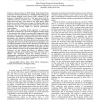Free Online Productivity Tools
i2Speak
i2Symbol
i2OCR
iTex2Img
iWeb2Print
iWeb2Shot
i2Type
iPdf2Split
iPdf2Merge
i2Bopomofo
i2Arabic
i2Style
i2Image
i2PDF
iLatex2Rtf
Sci2ools
LCN
2006
IEEE
2006
IEEE
Performance Limits and Analysis of Contention-based IEEE 802.11 MAC
— Recent advance in IEEE 802.11 based standard has pushed the wireless bandwidth up to 600Mbps while keeping the same wireless medium access control (MAC) schemes for full backward compatibility. However, it has been shown that the inefficient protocol overhead casts a theoretical throughput upper limit and delay lower limit for the IEEE 802.11 based protocols, even the wireless data rate goes to infinitely high. Such limits are important to understand the bottleneck of the current technology and develop insight for protocol performance improvements. This paper uses a queuing system approach to extend the discussions of IEEE 802.11 protocol throughput and delay limits to the situation that arbitrary non-saturated background traffic is present in the network. We derive analytical models to quantify the limits for Distributed Coordination Function (DCF) of legacy 802.11a/b/g and Enhanced Distributed Coordination Access (EDCA) of IEEE 802.11e. We find such limits are functions of the un...
| Added | 12 Jun 2010 |
| Updated | 12 Jun 2010 |
| Type | Conference |
| Year | 2006 |
| Where | LCN |
| Authors | Shao-Cheng Wang, Ahmed Helmy |
Comments (0)

